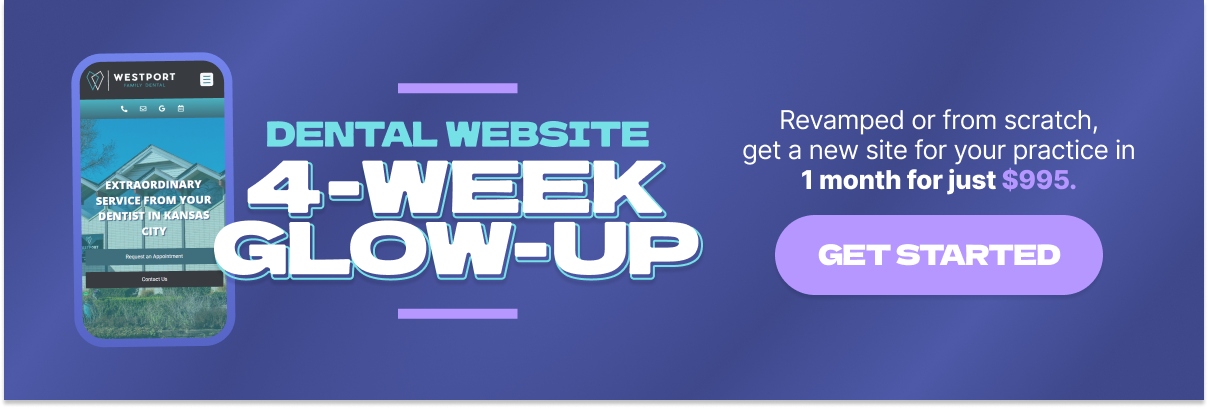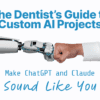
Dental Website SEO Basics
When it comes to getting your dental practice found online, there’s one part of your website that you have complete control over: on-page SEO. That means the content, structure, and behind-the-scenes details that help search engines understand what your site is about.
In 2025, dental website SEO is less about chasing algorithms and more about delivering a great experience to real people, meaning your potential patients. Whether you’re trying to rank for “Invisalign in Salt Lake City” or simply want to show up when someone Googles “best dentist near me,” mastering on-page SEO is the foundation.
In this guide, we’ll break down exactly what you need to do to make your dental website more visible, user-friendly, and conversion-ready. From headers to image alt text, we’ll cover the latest best practices with practical tips you can implement today.
Table of Contents
- Organize Content for Patients, Not Just Google
- Headers and Titles: Make Every Word Count
- Internal Links: Guide Visitors Like a Pro
- Image Optimization for Dental Websites
- Technical Touches that Make a Difference in Dental Website SEO
- Meta Descriptions: The Secret to More Clicks
- Common Pitfalls Dentists Should Avoid
- Build a Dental Website That Ranks and Converts
- FAQ
Optimize Content for Patients, Not Just Google
Great dental website SEO starts with writing for people, not search engines. While Google’s algorithms are smarter than ever, they’re still trying to understand what real humans want. That means your content should focus on answering patient questions clearly, using the words and phrases they’re actually searching for.
Instead of stuffing pages with keywords like “best family dentist in Phoenix,” write naturally and focus on the patient’s experience. For example, a service page about dental implants should explain what the procedure involves, how long recovery takes, and what makes your practice the right choice. Real, helpful information always beats vague or overly technical jargon, whether you’re writing for your dental blog or a service page.
A few content tips specifically for dental websites:
- Speak your patients’ language. Swap out “edentulism” for “missing teeth,” and “prophylaxis” for “dental cleaning.”
- Use questions as headings. Many patients search in the form of questions. Try headers like “Does a root canal hurt?” or “How long does Invisalign take?”
- Add patient education and visuals. Diagrams, before-and-after photos, and videos help explain procedures and keep visitors engaged.
Google rewards clarity and relevance. The more your content matches what patients are searching for—and the more helpful it is—the more likely your pages are to rank and convert.
Headers and Titles: Make Every Word Count
Think of headers and titles as the street signs of your dental website. They guide both your visitors and search engines through your content, helping them understand what each page is about, and why it matters.
Start with a strong H1. Every page should have one main header (H1), and it should clearly reflect the topic of the page. For a dental implants page, your H1 might be “Dental Implants in Austin” or “Replace Missing Teeth with Dental Implants.”
Use H2s and H3s to structure content. Subheadings help break up your page into easy-to-digest sections. They also give search engines context. Instead of vague subheadings like “Why Us,” use something more descriptive, such as “Why Our Patients Choose Us for Dental Implants.”
Avoid using headers for style only. Don’t use H tags just to make text look bold or large. Headers should organize content, not just decorate it.
Craft title tags that attract clicks. Your title tag is what appears in search results. It should be specific, include your target keyword, and offer a reason to click. For example:
- Weak title: “Our Services – Smith Dental”
- Strong title: “Gentle, Affordable Family Dentistry in Denver – Smith Dental”
Keep it natural, not stuffed. Don’t force keywords into every heading or title. Use the phrases your patients use, and write like a human, not a robot.
Internal Links: Guide Visitors Like a Pro
Internal linking is about giving your patients a better experience on your website. Smart internal links help visitors navigate your site, discover related services, and take the next step toward becoming a patient.
Link between related services. If someone is reading about cosmetic dentistry, link to your teeth whitening or veneers page. On your dental implants page, link to bone grafting or sedation options if they’re relevant. This keeps visitors engaged and helps search engines understand how your site is structured.
Use clear, descriptive anchor text. Instead of saying “click here,” use something like “learn more about our emergency dental care.” This tells both the user and search engines exactly what to expect when they click.
Keep your calls to action close. Want patients to book an appointment? Don’t make them dig for the button. Link to your contact or scheduling page from every service page and blog post using a strong CTA like “Request a Consultation” or “Schedule Your First Visit.”
Avoid overloading your pages with links. More isn’t always better. Focus on links that add value and guide your visitor through a logical journey.
Include footer and menu links—but be strategic. These site-wide links are great for usability and can help with SEO if they’re well-organized and keyword-relevant.
Every link on your site is an opportunity to keep your visitors moving toward conversion. When done right, internal linking builds trust, improves SEO, and makes your website feel seamless and professional.
Image Optimization for Dental Websites
Your dental website probably features a lot of visuals like photos of your team, your office, before-and-afters, and even diagrams explaining procedures. But if those images aren’t optimized, you’re missing out on a key part of dental website SEO.
Start with smart file names. Before uploading, rename your images to reflect what they show. Instead of “IMG_1234.jpg,” use something like “dental-implant-surgery-prep.jpg” or “smile-makeover-before-after.jpg.” This helps search engines understand the content of your images.
Always use alt text. Alt text serves two important purposes: it improves accessibility for users with visual impairments, and it gives search engines context. For example, alt text for a team photo might be “Dr. Miller and the team at Bright Smiles Dental, Salt Lake City.”
Don’t forget image descriptions. Adding a short image description can give search engines even more detail, especially if the image supports a specific service or point.
Compress for speed. Large image files can slow down your site, which hurts both SEO and user experience. Use tools like TinyPNG or WebP formatting to reduce file sizes without sacrificing quality.
Use original photos when possible. Stock photos are fine in moderation, but real photos of your practice, staff, and patients (with consent) build trust and boost local SEO authenticity.
Technical Touches That Make a Difference in Dental Website SEO
You don’t need to be a web developer to make sure your dental website checks the right technical boxes. A few simple updates behind the scenes can make a big difference in how your pages rank—and how fast they load.
Speed matters, but don’t obsess. Patients expect your site to load quickly, especially on mobile. Use tools like Google PageSpeed Insights or GTmetrix to check for performance issues. Simple fixes like image compression, browser caching, and lazy loading can go a long way.
Use schema markup to boost visibility. Schema is a type of code that helps search engines understand what your page is about. For dental websites, local business schema, review schema, and service schema are especially helpful. They can even improve your appearance in search results with star ratings or featured snippets.
Implement canonical tags correctly. If you have similar or duplicate content (for example, service pages that vary by location), use canonical tags to tell Google which version is the “official” one. This avoids duplicate content penalties and keeps your SEO efforts focused.
Check your meta robots settings. These tags tell search engines which pages to index and follow. Use them wisely—your main pages should almost always be set to “index, follow,” while temporary pages or landing pages can use “noindex” to keep things clean.
Make clickable elements clear. Buttons, forms, and calls to action should be easy to find and clearly labeled. Use action words like “Book an Appointment,” “Download Your New Patient Form,” or “Learn More About Invisalign.”
Meta Descriptions: The Secret to More Clicks
Meta descriptions don’t directly impact your rankings, but they can absolutely influence how many people click on your listing in search results. Think of them as your elevator pitch: just a sentence or two to convince someone your page is worth visiting.
Write for people, not bots. Your meta description should clearly explain what the page is about and why it matters to the reader. For example:
“Need a gentle dentist in Omaha? We offer same-day crowns, cleanings, and emergency care in a welcoming, family-friendly office.”
Keep it short and focused. Aim for around 150 to 160 characters. Too short, and you miss your chance to stand out. Too long, and it might get cut off in search results.
Include local keywords. Mention your city or neighborhood when it makes sense. People often search for phrases like “dentist near downtown Chicago” or “pediatric dentist in Tampa.”
Match your tone to your brand. Whether your practice is warm and friendly or modern and high-tech, let your brand voice come through.
Avoid duplication. Don’t use the same meta description across multiple pages. Each page should have a unique snippet tailored to its content.
Even though Google sometimes rewrites meta descriptions, having a well-written one gives your page a better chance of standing out in a crowded search result, and that can make all the difference when a patient is deciding which dental website to click on.
Common Pitfalls Dentists Should Avoid
Even with the best intentions, it’s easy to make SEO mistakes that can hurt your visibility or frustrate visitors. Here are some of the most common on-page SEO missteps we see on dental websites and how to avoid them.
Keyword stuffing. Repeating the same dental keyword over and over (“best dentist in Dallas” five times in one paragraph) doesn’t help your rankings. It makes your content sound unnatural and can actually lower your credibility with both Google and potential patients. Focus on writing clearly and answering real questions.
Vague or generic headers. Titles like “Welcome” or “Our Services” don’t tell search engines what the page is about. Be specific. Instead of “Our Difference,” try “Why Patients Trust Our Gentle, Modern Dental Care.”
Neglecting accessibility. Skipping alt text on images or using poor color contrast makes your site harder to use for patients with visual impairments. And if users can’t access your site, search engines won’t prioritize it.
Overusing stock photos. Too many generic images can make your site feel impersonal. Whenever possible, use real photos of your team, office, and patients (with proper permissions). It builds trust and helps you stand out locally.
Ignoring page speed and mobile usability. A slow-loading site or one that’s hard to use on a phone will drive visitors away. Many dental patients search on mobile, especially for emergency services—make sure your site loads quickly and looks great on every device.
Skipping meta titles and descriptions. Leaving these out or duplicating them across multiple pages means missed opportunities to stand out in search results.
Build a Dental Website That Ranks and Converts
Strategic on-page SEO creates a clear, fast, and helpful experience for both your patients and search engines. By optimizing each page of your site with the right content structure, internal links, image tags, and technical details, you’re not only improving your search rankings, you’re building trust with potential patients.
Think of it as digital chairside manner. When your website answers questions clearly and loads quickly, it shows patients that you care about their time and their needs before they even pick up the phone.
Frequently Asked Questions
How do I improve my dental website’s SEO?
Start by optimizing the content on your key service pages with clear, patient-focused language. Use relevant keywords naturally, structure your content with headers, and include internal links to related services or blog posts. Don’t forget to optimize your images with descriptive file names and alt text. Finally, make sure your site loads quickly and looks great on mobile devices. All of these tips can instantly improve your dental website SEO.
What should be included on a dentist’s homepage for better SEO?
Your homepage should clearly state who you are, where you’re located, and what dental services you offer. Use a strong H1 header, a compelling meta title and description, and link to your most important pages (like services, about, and contact). Adding local keywords like your city or neighborhood can also help your homepage show up in local search results.
Does blogging help with dental SEO?
Yes, blogging is one of the best ways to improve dental website SEO. Regular blog posts can target long-tail keywords (like “how long does teeth whitening last”), answer common patient questions, and build authority over time. Plus, blogs give you fresh content to share on social media, which drives traffic and signals relevance to search engines.
About the Author: Megan Nielsen is an SEO strategist and the Grand Overlord of copywriting at My Social Practice. My Social Practice is a dental marketing company that offers a full suite of dental marketing services to thousands of dental practices throughout the United States and Canada.


![[Byte Sized Podcast Ep. 25] Your SEO Strategy is Dead: Why AI Just Killed Traditional Search Feat. Ridgely Goldsborough - dental website seo - My Social Practice - Social Media Marketing for Dental & Dental Specialty Practices My Social Practice - Social Media Marketing for Dental & Dental Specialty Practices - dental website seo](https://mysocialpractice.com/wp-content/uploads/2026/01/byte-sized_ep25.png)






![[Byte Sized Podcast Ep. 25] Your SEO Strategy is Dead: Why AI Just Killed Traditional Search Feat. Ridgely Goldsborough - dental website seo - My Social Practice - Social Media Marketing for Dental & Dental Specialty Practices My Social Practice - Social Media Marketing for Dental & Dental Specialty Practices - dental website seo](https://mysocialpractice.com/wp-content/uploads/2026/01/byte-sized_ep25-100x100.png)

